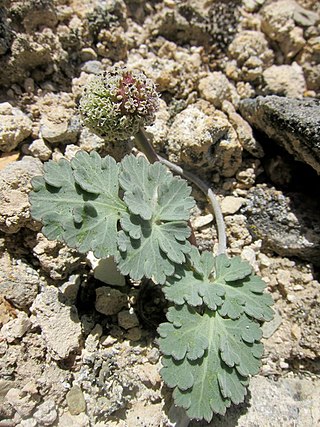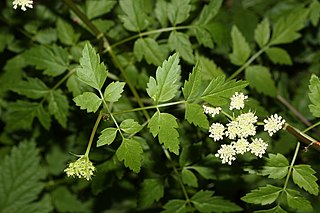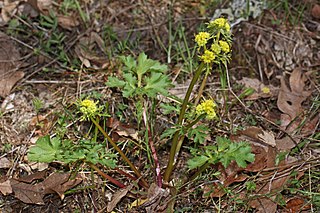
Torilis is a genus of plants in the family Apiaceae which are known generally as the hedge parsleys. They are native to Eurasia and North Africa but have been introduced to other continents. T. arvensis is quite widespread in North America but is facing population decline in the UK.

Cymopterus globosus is a species of flowering plant in the carrot family known by the common name globe springparsley. This plant is native to the sandy flats extending between eastern California and Utah in the western United States. It is a low, stemless plant with leaves parallel to or lying flat on the ground. The green-gray parsley-shaped leaves are divided into several leaflets, which are further divided into neatly pointed segments. One or more tall purple or red-brown peduncles hold an inflorescence which is a spherical umbel densely packed with white or pinkish-purple flowers. They may be held in pairs atop the peduncle, and are often heavy enough to bend the peduncle to the ground.

Allium cratericola is a species of wild onion known by the common name Cascade onion. It is endemic to California, where is an uncommon member of the flora in several of the state's mountain ranges, including the northern and southern California Coast Ranges, the western Transverse Ranges, Klamath Mountains, and the Sierra Nevada foothills. Its range covers much of the state, from Riverside County to Siskiyou County.

Calochortus dunnii is a rare species of flowering plant in the lily family known by the common name Dunn's mariposa lily.

Cytisus multiflorus is a species of legume known by the common names white broom, white spanishbroom and Portuguese broom.

Oenanthe sarmentosa is a species of flowering plant in the family Apiaceae known by the common name water parsley. It is native to western North America from Alaska to California, where it grows in wet areas, such as streambanks. It is sometimes aquatic, growing in the water. The plant has been used in cultivation in wetlands, and the recent discovery of several colonies growing by a stream in Illinois demonstrates its capacity to become a noxious weed if it is introduced elsewhere. This is a perennial herb growing to a maximum height near 1.5 meters. The leaves have blades up to 30 centimeters long borne on petioles up to 35 centimeters in length. The parsley-like leaf blade is divided into serrated, lobed leaflets. The inflorescence is a compound umbel of many flowers with bright white to red-tinged petals.

Polemonium micranthum is a species of flowering plant in the phlox family known by the common names annual polemonium or annual Jacob's-ladder. It is native to western North America from British Columbia to North Dakota to California as well as disjunct in the Andes of southern Argentina and Chile. It can be found in many types of shrubby habitat, such as sagebrush scrub and foothill woodlands. It is an annual herb with a branching or unbranched stem taking a matted, spreading, or upright form. The slender stems are up to about 30 centimeters long and the herbage is coated in short, soft hairs and stalked glands. The leaves are located along the stem, each divided into several small leaflets. The solitary flowers have small white or pale blue lobed corollas tucked within cuplike calyces of hairy, pointed sepals.

Potentilla norvegica is a species of cinquefoil known by the common names rough cinquefoil, ternate-leaved cinquefoil, and Norwegian cinquefoil. It is native to Europe, Asia, and parts of North America, and it can be found elsewhere as an introduced species.

Psorothamnus polydenius is a species of flowering plant in the legume family known by the common names Nevada dalea and Nevada indigobush. It is native to the deserts of the southwestern United States from the Mojave Desert in California to Utah.

Psorothamnus schottii is a species of flowering plant in the legume family known by the common name Schott's dalea. It is native to the Sonoran Deserts of northern Mexico and adjacent sections of Arizona and the Colorado Desert in California.

Rumex pulcher is a species of flowering plant in the knotweed family known by the common name fiddle dock. It is native to Eurasia and North Africa and it can be found elsewhere, including parts of North America, as an introduced species and a roadside weed. Europe. It is quite variable in appearance, and some authorities divide it into several subspecies that are more or less distinguishable. In general, it is a perennial herb producing a slender, erect stem from a thick taproot, approaching 70 centimeters in maximum height. The top of the plant may bend, especially as the fruit develops. The leaves are up to 10 or 15 centimeters long and variable in shape, though often oblong with a narrow middle in the rough shape of a fiddle. The inflorescence is made up of many branches, each an interrupted series of clusters of flowers with up to 20 in each cluster, each flower hanging from a pedicel. The flower has usually six tepals, the inner three of which are edged with teeth and have tubercles at their centers.

Torilis japonica, the erect hedgeparsley, upright hedge-parsley or Japanese hedge parsley, is a herbaceous flowering plant species in the celery family Apiaceae. Japanese hedge parsley is considered both an annual and biennial plant depending on the biogeographical location. This means Japanese hedge parsley can complete its life cycle in either one or two growing seasons depending on habitat. Japanese hedge parsley is typically found in areas with disturbed soils, pastures, margins, open woodland, near waste sites, or right-of-way habitats. It can withstand a variety of habitats, thriving in partial and full shaded areas, but also withstanding habitats with full sunlight penetration. It is considered an aggressive invasive species in North America; invading a wide range of habitats due to its environmental tolerance and tendency to outcompete native vegetation. This species is considered a threat in several areas that causes problems relating to overall environmental health and stability. Aside from its environmental implications, T. japonica has potential to fight several cancers through a terpene it produces called Torilin, extracted from its fruits.

Sanicula graveolens is a species of flowering plant in the family Apiaceae known by the common names northern sanicle and Sierra blacksnakeroot. It is native to western North America from British Columbia to Montana to California, and southern South America, including southern Chile. Its habitat includes mountain slopes, forests, and woodlands on serpentine soils. It is a perennial herb producing a slender, branching stem up to half a meter tall from a taproot, with leaves alternate. The lowest leaves have long stalks and are often attached below ground. The upper leaves are smaller, sparse and often sessile. The leaves are compound, the blades each divided into three deeply lobed, toothed leaflets. The herbage is green to purple-tinged to all purple in color. The inflorescence is made up of one or more heads of bisexual and male-only flowers with tiny, curving, yellow petals. Each head has an array of narrow, toothed bracts at its base. The rounded fruits are a few millimeters long, covered in curving prickles, and borne in small clusters.

Sanicula tuberosa is a species of flowering plant in the parsley family known by the common name turkey pea. It is native to western North America from Oregon through California to Baja California, where it can be found in many types of habitat, including chaparral, forests, and woodlands. It is variable in appearance. In general, it is a perennial herb producing a slender stem up to 80 centimeters long from a small, spherical tuber no more than 2 centimeters wide. The leaves are compound, divided into usually three leaflets which are smooth or deeply cut into lobes. The herbage is green to purple in color. The inflorescence is made up of one or more heads of bisexual and male-only flowers with tiny, curving, yellow petals. The fruits are 1 or 2 millimeters long and covered in bumpy tubercles.

Silene invisa is a species of flowering plant in the family Caryophyllaceae known by the common names red fir catchfly and short-petaled campion.

Angelica capitellata, synonym Sphenosciadium capitellatum, is a species of flowering plant in the family Apiaceae. When treated as Sphenosciadium capitellatum, it was the only species in the monotypic genus Sphenosciadium. It is known by the common names woollyhead parsnip, ranger's buttons, button parsley, and swamp white heads.

Stachys arvensis is a species of flowering plant in the mint family known by the common names field woundwort and staggerweed. It is native to Europe, Western Asia, and North Africa. It is known on other continents as an introduced species and widespread weed.

Thermopsis gracilis is a species of flowering plant in the legume family known by the common name slender goldenbanner.

Torilis nodosa is a species of flowering plant in the family Apiaceae known by the common names knotted hedgeparsley and short sock-destroyer. It is native to parts of Europe, especially the Mediterranean Basin and it is known elsewhere, such as North America, as an introduced species and a common weed. It grows in many types of habitat, particularly disturbed areas. It is an annual herb producing a hairy stem up to half a meter in maximum height. The alternately arranged leaves are each divided into several pairs of smooth-edged lance-shaped or linear leaflets. The inflorescence is a dense compound umbel of flower clusters on very short rays, often appearing like a cluster. Each flower has five petals which are unequal in size and are white with a pinkish or reddish tinge. Each greenish or pinkish fruit is about 3 millimeters long and is coated in long prickles.

Drymocallis glandulosa, formerly Potentilla glandulosa, known by the common names Douglas' wood beauty and sticky cinquefoil, is a plant species in the family Rosaceae.




















